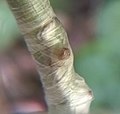
Chip budding is a grafting technique
A chip of wood containing a bud is cut out of scion with desirable properties (tasty fruit, pretty flowers, etc.). A similarly shaped chip is cut out of the rootstock, and the scion bud is placed in the cut, in such a way that the cambium layers match. The new bud is usually fixed in place using grafting tape.
Chip budding can be done in mid- to late summer, unlike most grafting which takes place in the early spring. Depending on sap flow, the bud may not begin growing until the following spring, though you can determine if the grafting succeeded before that by seeing whether the bud swells or shrivels. The next spring, all other shoots than that from the scion bud are removed, which will then become the source for the new top of the plant.
-
 Chip budding of a rose
Chip budding of a rose
-
 5 days later, the bud shoots through the parafilm protection
5 days later, the bud shoots through the parafilm protection
-
 7 days later
7 days later
-
 10 days later
10 days later
References
- ^ "Chip budding / RHS Gardening". Retrieved 25 September 2019.
- Stoltz, Leonard P.; Strang, John (November 1, 2005). "Reproducing Fruit Trees by Graftage: Budding and Grafting" (PDF). Cooperative Extension Service – via University of Kentucky.
External links
- chip budding part 2 - Demonstration of chip budding by Stephen Hayes
This botany article is a stub. You can help Misplaced Pages by expanding it. |